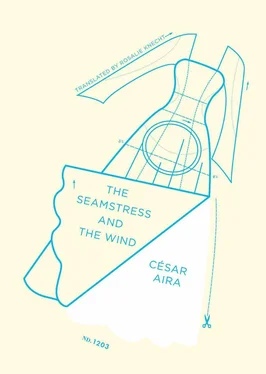I should at least take advantage of this experience, she managed to say to herself, since there won’t be another one to follow it.
But that was, from any point of view, impossible. Enjoyment is impossible when everything is impossible; what’s more, there was no point of view; the show she was putting on didn’t have a point of view, since there was no one to see it. There in the limpid heights of twilight, she spun around so many times at a speed greater than sound, that she no longer had relative positions. She was a collage, a figure cut out and moved by a capricious artist, filmed in fast-forward against the pinkest and smoothest backdrop in the world (or in the sky) and illuminated by a red spotlight. No one enjoys the experience immediately before death, ever. Although, of course, with death, the quintessentially unexpected, no experience can be called the last. There’s always the possibility that it’s the next-to-last. This was an error on Delia’s part (her last moments!), the first of a strange series that would carry her very far.
Some things seem eternal, and still they pass anyway. Death itself does that. Delia had lost sight of the earth a little while before, and she no longer knew if she was moving forward or backward, falling or rising, following the vertical or the horizontal. . What did it matter, at that point? There was always a new wind to take hold of her and play yo-yo with her. Where did they come from, those winds? The torrent seemed to come from a hole in the sky — the hole was invisible.
But, as I say, suddenly it was over. Delia found herself on the earth again, and walking. She really didn’t know how it happened. But, there she was walking on her two legs, on the flat, clean-swept earth. She didn’t see a tree, a hill, anything. She forgot immediately the danger of death she had just faced.
Delia loved to play the committed fatalist, the lady of death — every afternoon she felt prepared to spend the night at a wake; her conversations were full of cancer, blindness, paralysis, comas, heart attacks, widows, orphans. She had embodied this character with so much enthusiasm that it was now her theme, her position. It was an inclination she had chosen, because the safe and protected life she’d led, the cocoon of the small town middle class, placed her on the margin of any serious test in which her survival could be at stake. Her desire to live was exempt from any corroboration. And this also formed a part of her definitive being. While she flew, with no time to think or react (which are the same thing), she had clung to her old philosophy. Yet now that she was walking, safe and sound, time was opening up beneath her feet; her legs were the scissors that cut the translucent stalk of time and continuously opened and unfolded it. And because of this she saw before her the urgent necessity to give way to certain ideas about reality and to renounce momentarily that “what does it matter, I’m dead already anyway” that constituted her elegance.
She didn’t know where she was or where she was headed — or even what time it was. To start with, how was it possible that it was daytime? It was night, she felt that in her body and her mind. And yet, it was day. What insane zone had she fallen into?
Then this is Patagonia? she said to herself, perplexed. And if this is Patagonia, then what am I?
MEANWHILE, WHEN NIGHT had almost fallen, Ramón Siffoni returned to the neighborhood in his little red truck and found a committee of anguish waiting for him.
“Omar wasn’t lost!” he began, but he stopped there, because he sensed that no one was listening. He was a nervous and bad-tempered man, impatient, demanding and dissatisfied. “ Where’s my wife?” he asked.
This was what the neighbors were waiting for.
“She took a taxi to Patagonia.”
If they’d bored a hole in the back of his neck with a drill they couldn’t have shaken him more badly.
They explained it to him, but who knows if anything got through his crust of rage. But something must have gotten through, because he got back into his red wreck of a truck and took off with a noise like rattling tin cans — also headed south, where everyone seemed to be going that day.
What he didn’t see was parked on the corner — a little sky-blue one-seater car, the kind that had to be dismantled from the top for the driver to get in: it began to follow him. Such a maneuver was highly unusual, perhaps the first, and the last time, such a thing happened in Pringles.
And even so, it went unnoticed. The neighbor women were dazzled by the abrupt gesture, romantic in its way, of the angry husband. And Ramón Siffoni. . what could he notice, in his state? He ran, he launched himself off, to keep his wife from committing the greatest mistake of her life. And if his old red truck was not as fast as it needed to be, it didn’t matter, because what he wanted at that moment was an interplanetary rocket ship.
He was going, as anyone with a map can verify, southeast. Which is to say, in the two directions that lengthen the day in the Argentine summer. And as he was beside himself, he was the southeast. That worked. The day began to lengthen like a snake, and the red truck, which in the immensities it now slid across was becoming truly small, was the blazing hungry head of the snake, with its tongue sticking out: the tongue was the crank with its two right angles which in his haste Ramón had forgotten to take off.
BUT HE WAS not alone. A half mile or so behind, the gaze of a lady at the wheel was fixed on his trail of dust, driving a little sky-blue car, one of the smallest and lightest ever constructed. The fact that it was as light as a yawn mattered less (or didn’t matter at all) in view of the important mystery the little car held. That was everything. That little car was the mystery, and it was more than that: it was mystery in motion. Those vehicles, made for mobility in cities, for short distances, were an eccentricity of the fifties and sixties, and forgotten afterwards. We called them “mice.” Only one not very fat person fit, and only if they were tightly folded-up. No one ever thought of traveling in one of those cars. And yet this one, a pale blue example of the tiniest model, threw itself into the longest and most dangerous chase, almost like a miniature replica of something else — a toy intruding into the adult world. Surrounding it, Patagonia, gigantic and deserted, was beginning to open its vast mouth. But the car was not afraid. It pressed on, at full speed, almost as if it knew where it was going, or as if it were going somewhere. Or as if it were not going anywhere. It was the magnet-car, the soda bubble in the wind, the blue point of the sky, mystery in all its dimensions. The proverb says mystery does not occupy space. All right, fine; but it crosses it.
VERY WELL. NOW all the protagonists in the adventure are on stage. Let me see if I can make an orderly list:
1) The huge tractor trailer, Chiquito’s double planet, leading the way.
2) The shell of Zaralegui’s Chrysler, at this point looking more than anything like a black lacquered Chinese bathtub.
3) Zaralegui’s corpse.
4) Delia Siffoni, lost and wandering around.
5) Silvia Balero’s wedding dress, carried by the wind.
6) Ramón Siffoni in his red truck (a day behind).
7) And closing the retinue, the mysterious little blue car.
Of course, it’s not that simple. There are other characters, who are now going to appear. . Or better yet, no. It’s not that there are other characters (these are all of them) but revelations will transform these characters into others, making room for encounters that Delia Siffoni never would have expected, neither she nor any of the other Delia Siffonis in the world, with all of them beginning, there in Patagonia, a dance of transformations.
Читать дальше












